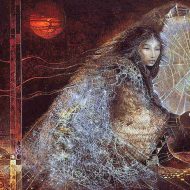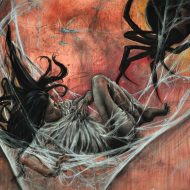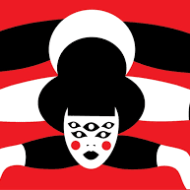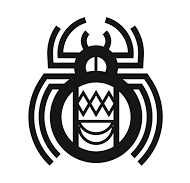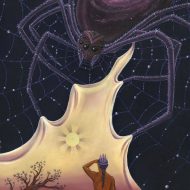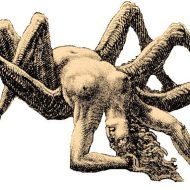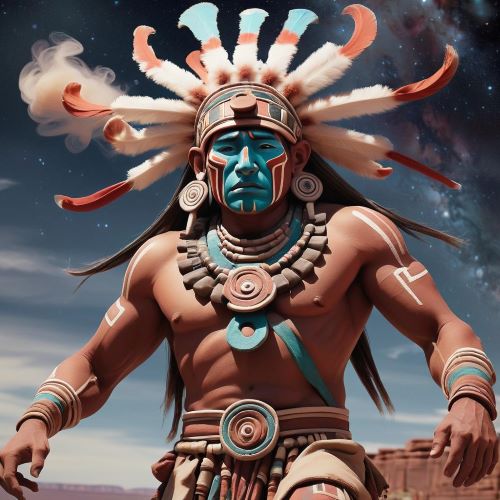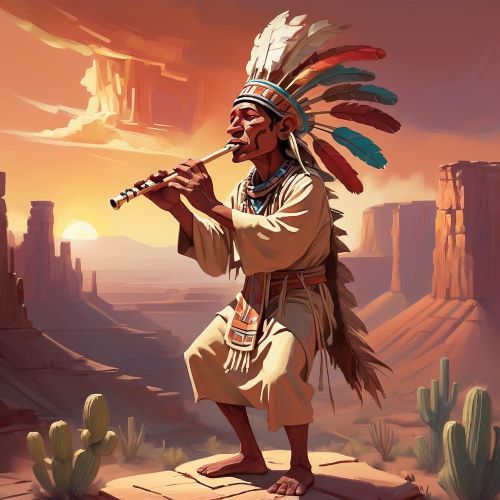Kokyangwuti : The Spider Grandmother of Creation
Listen
Kokyangwuti
Introduction
Kokyangwuti is a revered deity in Hopi mythology, often epitomized as the Spider Woman. She emerges as a vital figure responsible for creation and the interconnectedness of life within the universe. This archetype is not only central to the spiritual beliefs of the Hopi people but also represents larger themes within Native American cultures. Kokyangwuti embodies nurturing, protection, creativity, and transformation, serving as both a maternal figure and a cultural symbol. The rich tapestry of her stories weaves together themes of life, death, and the cyclical nature of existence that are integral to Hopi spirituality and mythology.
Physical Traits
The physical appearance of Kokyangwuti is often depicted in various forms, symbolizing her multifaceted nature. She is commonly associated with the traditional image of a spider; however, her depiction encompasses both anthropomorphic and non-anthropomorphic traits. Some artistic representations illustrate Kokyangwuti with the features of a woman adorned with a complex headdress or attire that includes motifs of webs and natural elements that signify fertility and creation. Her connection to nature further emphasizes her role as a nurturing force, with the ability to weave life through her symbolism of the web.
Family
In Hopi tradition, Kokyangwuti is considered a motherly figure with deep familial connections. She is often linked to Tawa, the Sun God, and together, they represent dualistic principles of creation. This partnership is fundamental in Hopi cosmology, as it conveys the balance between the sun’s light (representing life) and the earth (representing sustenance). Kokyangwuti’s role as a maternal figure extends to the nurturing of humanity and the planet, as she is portrayed as a caregiver who teaches her children essential skills such as weaving and cultivating crops. Her familial associations enrich her narrative within Hopi traditions, portraying her as a fundamental source of wisdom and guidance.
Other Names
Kokyangwuti is also known as the Spider Grandmother, Spider Woman and Gogyeng Sowuhti. She is also refered by different names depending on the region or the tribe that worships her. Kokyangwuti is known by several names across different tribes and contexts. While “Spider Woman” is the most recognized title, other variations convey additional aspects of her character. In some narratives, she may be referred to simply as “Grandmother” or “Mother of All,” underscoring her roles within the community as a wise elder and protector. The diversity of names attributed to Kokyangwuti reflects the various regional interpretations and oral traditions surrounding her myth, revealing the intricate ways in which she is woven into the fabric of Hopi and broader Native American culture.
Powers and Abilities
Kokyangwuti is celebrated for her numerous powers and abilities, many of which encapsulate the essence of creation, protection, and nurturing. As a creator deity, she is credited with the birth of all beings and is responsible for teaching essential skills necessary for survival, such as agriculture, weaving, and pottery. Her knowledge extends to the natural world, invoking a deep connection with the elements and ecosystems that sustain life.
Moreover, Kokyangwuti possesses extraordinary wisdom that guides her people in their spiritual and physical journeys. Her ability to connect various beings through her web symbolizes interdependence and unity within creation. As the thread of life, she provides insights and teaches the importance of harmony between humanity and nature. Additionally, her protective aspects are highlighted through her roles in various myths, where she defends her people from malevolent forces and empowers them to overcome challenges.
Modern Day Influence
Kokyangwuti is still worshiped by the Native American tribes of Southwest USA and many tribes still keep their traditions alive. The concept of an old spider has been referenced in popular culture in the form of cartoons and characters in children’s books.
The influence of Kokyangwuti extends into the modern world as her archetype resonates within contemporary discussions on environmentalism, feminism, and indigenous cultural resurgence. Many indigenous rights activists draw upon the symbolism of Kokyangwuti to advocate for sustainable practices and respect for Mother Earth’s resources, reflecting her teachings of interconnectedness. The resurgence of interest in ancient myths and their relevance today positions Kokyangwuti as a figure of empowerment and resilience in indigenous identities, particularly among women who see her as an embodiment of strength and wisdom.
In arts and literature, Kokyangwuti continues to inspire contemporary artists and scholars who explore Native American spirituality. The adaptation of her stories in children’s books, plays, and visual arts serves to bridge traditional narratives with modern audiences, ensuring the continuity of her legacy. Furthermore, educational initiatives aimed at teaching indigenous mythology often highlight Kokyangwuti’s role, fostering a greater appreciation for the depth and complexity of Native American cultural heritage.
Related Images
Source
McCoy, J. P. (1983). The Hopi Way. New York: Holt, Rinehart and Winston.
Courlander, H. (1972). Hopi Mythology. New York: The Macmillan Company.
Waters, F. (1963). The Book of the Hopi. New York: Viking Press.
Chulavist, J. D. (2008). Hopi Voices: History and Culture of the Hopi People. Tucson: University of Arizona Press.
Weller, G. M. (1991). The Emergence of the Hopi: Four Worlds of Creation. Flagstaff: Northland Publishing.
McCaffrey, P. (2009). Native American Mythology A to Z. New York: Facts on File.
Native Languages of the Americas. (n.d.). Spider Grandmother (Koyangwuti, Kokyangwuti). Retrieved from https://www.native-languages.org/spider-grandmother.htm native-languages.org
Beelinguapp Blog. (2024, November 21). Who Is Spider Grandmother?. Retrieved from https://beelinguapp.com/blog/who_is_spider_grandmother Beelinguapp
Symbolikon. (n.d.). Kokyangwuti – Hopi symbol. Retrieved from https://symbolikon.com/downloads/kokyangwuti-hopi/ symbolikon.com
Frequently Asked Questions
What does koyangwuti mean?
The primary meaning of “Koyangwuti” refers to a figure in Hopi mythology, representing a powerful and wise grandmother spider who embodies creation, weaving, and the interconnectedness of all things.
What is the myth of spider woman?
Spider Woman, revered across many cultures, is a powerful figure symbolizing creation, wisdom, and the interconnectedness of all things. In Navajo and Hopi traditions, she is a nurturing creator who teaches vital life skills like weaving and agriculture. As Asibikaashi among the Ojibwe, she protects children and offers healing. Though the Greek myth casts her as the prideful weaver Arachne, ultimately cursed by Athena, Spider Woman largely embodies benevolence, reminding us of our own creative potential and the delicate threads that bind us to one another.
What is the story of spider woman in Hopi?
In Hopi lore, Spider Woman, known as Koyangwuti, is the creator and guiding spirit. Emerging from the underworld, she spun the Earth from sand and clay, then breathed life into the first Hopi people. A teacher and protector, she gifted them with vital skills and established rituals for harmony. Through trials and transformations, she gained wisdom and emerged even stronger. Now a revered figure, she watches over the Hopi people, her web symbolizing the interconnectedness of all things.
How grandmother spider stole the sun?
When the world was cloaked in darkness, Grandmother Spider, with her wit and agility, used her web to capture a piece of the sun. Bringing this light back to the earth, she ended the endless night and ensured its daily journey across the sky. The sun’s rays, like the threads of her web, serve as a lasting reminder of her bravery and the transformative power of determination and wisdom.


